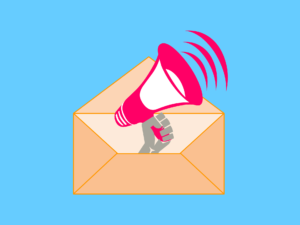3 Sneaky Tricks To Getting Your Headline Length Right

Getting your headline (subject line) right for your email is important. Most subscribers will base much of their behaviour on this aspect of your email. If it is too long, then important parts of your message will be missing, this could lessen the value of your email and result in a campaign that struggles.
The best length for a headline is between three to five words. Having it under 10 words is considered good, but the results of the campaign will start to lessen.
One of the main reasons for this is that more than half of all emails are now opened on mobiles and these have less space for subject lines. Therefore, you need them to be smaller to cater for this audience.
This can be challenging with certain subject lines. So, here are some sneaky tricks to get round the problem and make your headline just the right length.
1. Use The Preheader Text
The first aspect is to use the preheader text space as part of your subject line. This is a great place to put some content because it often appears with the subject line and combined they can make a valuable sentence that the audience can build your brand’s message with. For example:
Subject line: Get 10% off today when you spend more than $20.
could be changed to:
Subject line: Get 10% off today
Pre-header text: when you spend $20 or more.
Another example:
Subject line: Don’t miss out on our fantastic 10% off deal
this could be changed to:
Subject line: Don’t miss out
Pre-header text: on our fantastic 10% off deal.
2. Remove Unimportant Words
Sometimes we add words in sentences to make them grammatically correct, but they just aren’t needed culturally. Your audience will know exactly what you mean and would prefer to know what you’re saying with a few words, than only getting half the message because the text was cut short by their email client.
A good examples of this could be:
Subject line: Get 10% off today when you spend more than $20.
Could be changed to either:
Subject line: 10% off when you spend $20 or more
or
Subject Line: Spend $20 and save 10%.
The subject lines in both of these mean the same thing, but they’re just worded differently and take up less space.
3. Use Symbols/Emoji’s In Your Email Headlines
Another great example is to use symbols or emojis in your email subject lines instead of words. Subject lines with emojis in them have the added bonus of a higher click through rate. Symbols can also be used to convey messages in far shorter space.
A good example could be:
Subject line: Get 10% off today when you spend more than $20
could be changed to:
Subject line: Get 10% off today when you spend $20+
or
Subject line: Spend $20+ for 10% off.
A good way to use an emoji would be like this:
Subject line: Use these self-help books to make you happy.
You could change the books and happy words into emojis. There are lots of emojis that are available for you to use.
Conclusion
Headlines and subject lines are only supposed to be a certain length. Any longer and they will be too big for most email clients, especially those on mobile devices. There are numerous ways you can get around this by using some sneaky tricks to reduce the length.
We’ve highlighted three sneaky tactics you can use above. All will greatly reduce your subject line and make them more engaging. Some will even see better campaign results (like using emojis).
How do you reduce the length of your subject lines? Have you monitored subject lines for their performance?
Let us know in the comments below.
Read post Post a Comment. Tagged in: email design, Subject Lines
Subject Line Tricks To Improve Open Rates

When it comes to improving open rates, there are several aspects that are key. One of those is the subject line that the audience sees. If you have a boring subject line, then your mail can be lost in busy inboxes. However, if you make slight tweaks to your mail, then you can make it stand out and improve your campaign’s performance.
So, what are the subject line tricks you can use to improve open rates?
1. Bracketing Text
One of the newest ways that people have started to build upon their open rate is by including brackets in their subject lines. A line like this:
Some amazing daily deals that can’t be found elsewhere
can be turned into
Some amazing (exclusive) daily deals
The brackets used to be unusual. So it drew attention to the email in an inbox. However, more marketers are starting to do this, so consumers are going to get used to the practice soon. That doesn’t make it less valuable, there are still going to be some audiences who are more likely to click through on this type of subject line.
2. Avoid Blacklists (Spam) Words
Another key aspect to getting your emails opened is getting them seen in the first place. When you include spam words in your subject lines then mail servers are going to be blocking your content, making them bounce, or sending them to the spam folder, where few people check for emails.
There are a lot of words that can be considered bad for spam. So be sure to check out those lists carefully. We’ve even created an article recently where we detailed some of the worst options for words.
However, two good examples would be the words ‘daily’ and ‘deals’. These are often associated with spam and so should be removed and replaced. So this subject line:
Some amazing (exclusive) daily deals
could be turned into
Some amazing (exclusive) products available today.
3. Add Ownership To The Subject Line
Call-to-action optimisation is all about giving ownership of the action to the reader. The same can be said to email subject lines. After all, they are both there to tell the audience to do something. In the case of the email subject line, it is to read the rest of the content.
There are several ways to add ownership to a subject line. But the most powerful is by including the word ‘you’ somewhere in the text. While personalisation used to work, customers are becoming more aware of the technology that can just add it in. So placing a name within the subject line is becoming less effective.
Therefore, this subject line:
Some amazing (exclusive) products available today.
Could become
Some amazing (exclusive) products available for you today
4. Be Controversial And Keep A Secret (Very Badly)
Another key tactic used by numerous other people on email marketing is being controversial and implying a secret. This adds intrigue and a desire by the audience to know what is hidden within the email. Controversial aspects are hard to apply without offending certain elements, but there are ways of doing it.
You don’t have to use the word secret, or confidential within the content to get the secret element across. Instead, you can use words like ‘exclusive’ or ‘just for you’ to get that same sense. For instance, in the example above, we’ve used the word exclusive. That implies scarcity and secrecy. Therefore, audiences are more likely to click through.
To add controversy, you could add something like:
Some amazing (exclusive) products available for you (that your [name of relation] doesn’t want you to have)
The name of relation can be swapped with any relation like wife, husband, mum, dad, etc..
Conclusion
Improve your email marketing success with some of the tips above. When they see your new subject lines, you should see an increase in the number of people who are reading your content and therefore making a purchase.
How do you monitor your open rates? Have you tried split testing to see what subject lines perform better?
Let us know in the comments below.
Read post Post a Comment. Tagged in: email content, open rates, Subject Lines
The Best Email Marketing Subject Lines Ever

What are the best email marketing subject lines?
The subject line you use in an email is more important than you probably realise. 47% of email users will open an email based on the subject line alone. In addition, some 68% of email users will unsubscribe from an email marketing list based on your subject line.
These statistics aren’t surprising when the average person receives 100 emails per day. To stand a fair chance, research has shown that your email subject lines should be brief, descriptive and contain the following:
- Personalisation
- A reason for the reader to open the email.
- Urgency.
This sounds like a lot for a single line. But it is achievable. There are some great examples of email marketing subject lines, and they can often be grouped into several different categories.
Below we have given you some examples, so you can try to identify what subject lines most align with your offer and message. Then you can tailor these to be specific to your audience and brand.
Fear Of Missing Out
Nobody wants to miss an offer, and brands take advantage of this psychological need of consumers. Subject lines that want to use this either contain scarcity and/or urgency. Time-sensitive emails especially have proven to increase open rates.
Some good examples are:
- “Uh-oh, your prescription is expiring.”
- “You’re missing out on points.”
- “[URGENT] You’ve got ONE DAY to watch this…”
- “Your 7-figure plan goes bye-bye at midnight…”
- “[WEEKEND ONLY] Get this NOW before it’s gone…”
- “Mary, Earn double points today only.”
- “Tonight only: A denim lover’s dream.”
Two things to note; writing in capital letters is sometimes viewed as spam, and personalisation, such as including offers relevant to subscriber activity, can increase open rates.
Curiosity
People love to make discoveries, and email subject lines that attempt to hide some information can receive higher open rates. There are several ways you can do this, which include leaving your subject line open-ended or asking your audience a question.
Some good examples include:
- “*Don’t Open This Email*”
- “Last Day To See What This Mystery Email Is All About”
- “Is this the hottest career in marketing?”
- “9 Disgusting Facts about Thanksgiving”
- “A faster donkey.”
- “? a surprise gift for you! {unwrap}”
Humour
Including humour in your emails can be really successful because people love to laugh, which is why comedy programmes, like Friends and The Big Bang Theory, become huge hits and multimillion-dollar programs which keep viewers coming back again and again.
The two programs mentioned use their own version of the subject line (Episode Title) to make a humorous remark to entice audiences to take interest in the episode.
Likewise, you can create subject lines that make your audience laugh and want to open your email.
- “Deals That Make Us Proud (Unlike Our Nephew, Steve)”
- “Pairs nicely with spreadsheets”
- “Need a day at the beach? Just scratch n’ sniff your way to paradise…”
- “Try To Avoid These 27 People On New Year’s Eve”
- “Yes, I’m Pregnant. You Can Stop Staring At My Belly Now.”
- “NEW! Vacation on Mars”
Pain Point
If you really understand your buyers, which you should do, then you’ll know their pain and what they need to resolve their issues. Some good examples are:
- “Feed your guests without breaking the bank.”
- “Where do all these toys go?”
- “Get more kitchen space with these easy fixes.”
- “Stop wasting money on ink.”
- “Your beauty issues, solved”
- “Since we can’t all win the lottery…”
- “Stop wasting time on mindless work.”
- “Learn a language with only 5 minutes per day.”
Personalised
People want to feel special and that an email sent to them is literally only for them. They also want to have content that is relevant to their needs and behaviour. There’s no point sending a discount for kids’ clothes to someone who has no children!
Research has also shown that personalisation can boost email open rates by 29.3%.
Some good examples of personalisation emails are:
- “Mary, check out these hand-picked looks.”
- “Happy Birthday Mary – Surprise Inside!”
- “Mary, do you remember me?”
- “I didn’t see your name in the comments!?”
- “Are you coming?”
- “You’ve Changed”
- “So I’ll pick you up at 7?”
- “Crazy Invitation, I am Going to Buy You Lunch…”
- “Vanilla or Chocolate?”
- “Seriously, Who DOES This?”
- “you free this Thurs at 12 PM PST? [guest blogging class]”
- “Thanks for helping us.”
What subject lines will you use for your business? Have you tried any others that have worked well?
Let us know in the comments below.
Read post Post a Comment. Tagged in: best practices, email marketing strategy, Subject Lines
Short Subject Lines Or Long Subject Lines? What The Data Says…
 Email marketing is all about getting the attention of your audience. The first part of your message anyone will see is the subject line, and getting that right is paramount. Many articles give advice on the words you need to use in your subject line, but they often fail to mention the length.
Email marketing is all about getting the attention of your audience. The first part of your message anyone will see is the subject line, and getting that right is paramount. Many articles give advice on the words you need to use in your subject line, but they often fail to mention the length.
Having all the power words within your content may do you no good if you have a subject line that is too long to read. So what is best: short or long subject lines?
Not All Data Suggests The Same
The biggest problem with determining the ideal subject line length, is that not all the data is the same. It is all dependent on what campaigns are measured and the audience who received those campaigns.
For instance, those sending messages to the B2B sector will find that messages with subject lines of between six and ten words will get more open rates, but click through rates aren’t great. When there are more than 130 characters, the open rates drop significantly but the click through rates increase substantially. Finally, anything over 16 words sees a significant return on both clicks and opens.
Madhu Gulati
The president of ShowMeLeads has claimed that she has found a definitive answer for the length of an email. Research that analysed 260 million emails from 540 campaigns has led her to believe that there is a very specific word count that businesses should aim for.
According to the research:
- Subject lines with between six and ten words generated a 21% open rate.
- Subject lines with fewer than five words were opened on average 16% of the time.
- More than half of emails had between 11 and 15 words in the subject line and generated a 14% open rate.
Marketing Sherpa
Marketing Sherpa conducted research to find out whether or not longer subject lines were better than shorter messages. They looked at 9,313,885 emails for their research. Their results were different than those of ShowMeLeads.
Their results were as follows:
- The most popular length for subject lines was between 41 and 50 characters, yet it performed the first worst for open rates.
- Only 6% of emails had a subject line of between 61 and 70 characters, but these had the best open rates (17%).
- Email messages with between 51 and 60, or 91 and 100 characters performed the second best achieving 15% open rates.
Return Path
Finally, Return Path studied over 2 million emails to evaluate the correlation between subject line length and open rate. Their research also looked at the Pearson’s Correlation value, which suggested that there was no correlation between the length of the subject line and open rate.
However, they still advise keeping an eye on your subject line length. Their research demonstrated that:
- 25% of subject lines were between 41 and 50 characters.
- Open rates were greater when subject lines were between 61 and 70 characters.
- Only when there were more than 100 characters in a subject line did the open rate drop (down to 9%).
Desktop Versus Mobile
One of the important considerations is the device that your email is being read on. Desktop inboxes display approximately 60 characters whereas mobile devices show between 25 or 30 characters. Therefore, if your audience is mainly on mobile devices, then you need to shorten your subject lines, so the call to action or important message is at the beginning.
Conclusion
Email subject length might be an important factor in the success of your campaigns, but there is little evidence to suggest that a longer or shorter one will have a major impact. It might be all too dependent on your primary audience. Therefore, you should consider A/B testing your emails when deciding what works best for your audience.
What subject line length do you use? Have you ever tested it?
Let us know in the comments below.
Read post Post a Comment. Tagged in: email design, email subject line, Subject Lines
The Ideal Length For Your Email Subject Line
 We are often told that size doesn’t matter. Well that is wrong. Size does matter when it comes to your email subject line. It is the first impression your audience will have on what is contained within your marketing message. It needs to entice them to open the email and red further. Therefore, the subject line needs to be alluring, indicate what the message is about and not give away the whole story.
We are often told that size doesn’t matter. Well that is wrong. Size does matter when it comes to your email subject line. It is the first impression your audience will have on what is contained within your marketing message. It needs to entice them to open the email and red further. Therefore, the subject line needs to be alluring, indicate what the message is about and not give away the whole story.
This can be a difficult balancing act. Most people think they need to write an essay to achieve all three. While this can help, it can also be tough to read. Some try for the shortest email subject line they can manage. Yet this can seem non-descriptive.
Both camps claim they have the answer; yet, only research will tell what the impact is on the open rate for campaigns.
The Adestra Research Project
Adestra compiled some results from email marketing campaigns they were monitoring. They looked at how people interacted with a message and compared that to the email subject line. The results they saw were rather interesting. Firstly, they spotted that there was a sizeable bump in success when subject lines were between 10 and 30 characters long. Results either side of this mark were less than half.
Subject lines of this length are often offering a deal (i.e. Claim your 50% off today, etc). Therefore, it is normally business to customer messages that achieve success while being short.
Yet this wasn’t the only interesting result. Subject lines that were between 30 and 70 characters long achieved less than average responses while those over 100 characters seemed to perform well.
There was a particularly good set of results when email subject lines were 130 characters long.
ShowMeLeads Input
Another study conducted by the president of ShowMeLeads, Madhu Gulati, found another set of results that could turn the results above upside down. According to their research into 260 million emails sent during 540 campaigns, they found the following results:
- More than half (52%) of campaigns contained 11 to 15 words in the subject line. However, it had the poorest open rate.
- Those campaigns that contained between six and 10 words received a 21% open rate.
- Short subject lines (five words or less) had 16% open rates.
These results are almost in contrast to what was previously reported on Adestra.
MailChimp’s Results
MailChimp has also studied the problem. They came to the conclusion that length meant nothing and that it was the reader’s tastes that determined whether they would open your message up or not.
While there is some truth in this, looking at the MailChimp results there is something of note. Their results show an above rise in opens and clicks when the subject line is short. According to their data, you are bound to get the best results when your subject line is between 15 and 22 characters long.
This is rather important as it correlates with the other two studies.
Important Notes
It is important that click through rates shouldn’t be a huge factor on whether your subject line is best. Once the audience is at this point, other factors are determining their behaviour.
It is also important to note that none of these studies decided to a/b test the subject lines of exactly the same email to test the results. This might have given a better answer to the question.
To optimise your emails for your audience, consider a/b testing your email campaigns.
Conclusion
There are varying thoughts on what is the right length for an email subject line. Many consider that long subject lines distract audiences and lower success rates, yet others have demonstrated this is not the case. What all the studies do show is that a short, concise email subject line is going to perform better than the average.
What is the average length of your email subject line? What have your results been from your previous subject lines?
Let us know in the comments below:
Take Action:
- Use a short subject line to generate more opens.
- A/b test your subject lines to see what gets the best results.
Read post Post a Comment. Tagged in: email marketing, Email Testing, Online Marketing, Small Business, Subject Lines
The Real Secret to Email Subject Lines
 You’ll hear lots of talk about subject lines when researching email marketing.
You’ll hear lots of talk about subject lines when researching email marketing.
There are subject line best practices like:
- Keep subject lines short
- Use brand names in the subject line
- Use words like “New” and “Favorite” in your subject lines
These are all great tips, but there is really one simple rule to follow when it comes to creating subject lines. And you’re probably going to be disappointed when you read it because it’s something that’s not really a breakthrough idea at all.
Be interesting.
That’s it. That’s all there is to email subject lines. I think we tend to over think our email subject lines. We think about what will get people to open them, which is good, but we don’t give enough thought to what really makes people click. We ignore the psychology of email subject lines.
Read post Post a Comment. Tagged in: Mercola, Subject Lines